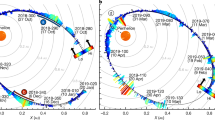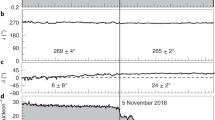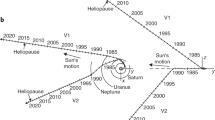Abstract
The outer limit of the Solar System is often considered to be at the distance from the Sun where the solar wind changes from supersonic to subsonic flow1. Theory predicts that a termination shock marks this boundary, with locations ranging2 from a few to over 100 au (1 au ≈ 1.5 × 108 km, the distance from Earth to the Sun). ‘Pick-up ions’ that originate3,4 as interstellar neutral atoms should be accelerated to tens of MeV at the termination shock, generating anomalous cosmic rays5,6,7. Here we report a large increase in the intensity of energetic particles in the outer heliosphere, as measured by an instrument on the Voyager 1 spacecraft. We argue that the spacecraft exited the supersonic solar wind and passed into the subsonic region (possibly beyond the termination shock) on about 1 August 2002 at a distance of ∼85 au (heliolatitude ∼34° N), then re-entered the supersonic solar wind about 200 days later at ∼87 au from the Sun. We show that the composition of the ions accelerated at the putative termination shock is that of anomalous cosmic rays and of interstellar pick-up ions.
This is a preview of subscription content, access via your institution
Access options
Subscribe to this journal
Receive 51 print issues and online access
$199.00 per year
only $3.90 per issue
Buy this article
- Purchase on Springer Link
- Instant access to full article PDF
Prices may be subject to local taxes which are calculated during checkout




Similar content being viewed by others
References
Parker, E. N. The stellar-wind regions. Astrophys. J. 134, 20–27 (1961)
Stone, E. C. News from the edge of interstellar space. Science 293, 55–56 (2001)
Fisk, L. A., Kozlovsky, B. & Ramaty, R. An interpretation of the observed oxygen and nitrogen enhancements in low-energy cosmic rays. Astrophys. J. 190, L35–L37 (1974)
Gloeckler, G. & Geiss, J. in AIP Conf. Proc. 598 Joint SOHO-ACE Workshop 2001 (ed. Wimmer-Schweinbruber, R.) 281–289 (AIP, Melville, NY, 2001)
Pesses, M. E., Jokipii, J. R. & Eichler, D. Cosmic ray drift, shock acceleration, and the anomalous component of cosmic rays. Astrophys. J. 246, L85–L88 (1981)
Steenberg, C. D. & Moraal, H. Form of the anomalous cosmic ray spectrum at the solar wind termination shock. J. Geophys. Res. 104, 24879–24884 (1999)
Fichtner, H. Anomalous cosmic rays: Messengers from the outer heliosphere. Space Sci. Rev. 95, 639–754 (2001)
Krimigis, S. M. et al. The Low Energy Charged Particle (LECP) experiment on the Voyager spacecraft. Space Sci. Rev. 21, 329–354 (1977)
McDonald, F. B. et al. Enhancements of energetic particles near the heliospheric termination shock. Nature 426 48–51 (2003)
Decker, R. B., Krimigis, S. M., McNutt, R. L., Hamilton, D. C. & Collier, R. M. Latitude associated differences in the low energy charged particle activity at Voyagers 1 and 2 during 1991 to early 1994. Space Sci. Rev. 72, 347–352 (1995)
Decker, R. B., Krimigis, S. M., Roelof, E. C. & Hill, M. E. Angular distributions and energy spectra of low-energy ions observed by Voyager 1 at 85–88 au. Geophys. Res. Abstr. 5, 03301 (2003).
Roelof, E. C., Simnett, G. M., Sanderson, T. R. & Kunow, H. Corotating interaction regions at high latitudes. Space Sci. Rev. 89, 225–233 (1999)
Decker, R. B., Roelof, E. C. & Krimigis, S. M. in Acceleration and Transport of Energetic Particles in the Heliosphere (eds Mewaldt, R. A., Zurbuchen, T. H. & Cummings, A. C.) AIP Conf. Proc 528, 161–165 (AIP, Melville, NY, 2000)
Decker, R. B. The role of magnetic loops in particle acceleration at nearly perpendicular shocks. J. Geophys. Res. 98, 33–46 (1993)
Sarris, E. T. & Krimigis, S. M. Quasi-perpendicular shock acceleration of ions to ∼200 MeV and electrons to ∼2 MeV observed by Voyager-2. Astrophys. J. 298, 676–683 (1985)
Kane, M., Decker, R. B., Mauk, B. H. & Krimigis, S. M. The solar wind velocity determined from Voyager 1 and 2: Low Energy Charged Particle measurements in the outer heliosphere. J. Geophys. Res. 103, 267–276 (1998)
Hill, M. E., Hamilton, D. C. & Krimigis, S. M. Evolution of anomalous cosmic-ray oxygen and helium energy spectra during the solar cycle 22 recovery phase in the outer heliosphere. Astrophys. J. 572, L169–L172 (2002)
Burlaga, L. F. et al. Search for the heliosheath with Voyager 1 magnetic field measurements. Geophys. Res. Lett. (in the press)
Fisk, L. A. Motion of the footpoints of heliospheric magnetic field lines at the sun: Implications for recurrent energetic particle events at high heliographic latitudes. J. Geophys. Res. 101, 15547–15553 (1996)
Schwadron, N. A. & McComas, D. J. Heliospheric “FALTS”: Favored acceleration locations at the termination shock. Geophys. Res. Lett. 30, doi: 10.1029/2002GL016499 (2003)
Izmodenov, V. V., Gloeckler, G. & Malama, V. When will Voyager 1 and 2 cross the termination shock? Geophys. Res. Lett. 30, 3–14 (2003)
Fahr, H. J. & Rucinski, D. Neutral interstellar gas atoms reducing the solar wind Mach number and velocity. Astron. Astrophys. 350, 1071–1078 (1999)
Fahr, H. J., Kausch, T. & Scherer, H. A five fluid hydrodynamic approach to model the solar system-interstellar medium interaction. Astron. Astrophys. 357, 268–282 (2000)
Neugebauer, M. Spacecraft observations of the interaction of active comets with the solar wind. Rev. Geophys. 28, 231–252 (1990)
Cargill, P. J., Hizanidis, K. & Papadopoulos, K. in Cometary and Solar Plasma Physics (ed. Buti, B.) (World Scientific, New York, 1988)
Gleeson, L. J. & Axford, W. I. The Compton-Getting effect. Astrophys. Space Sci. 2, 431–437 (1968)
Roelof, E. C. in Lectures in High Energy Astrophysics (eds Ogelman, H. & Wayland, J. R.) Ch. VII (NASA SP-199, 1969)
Zwickl, R. D. & Roelof, E. C. Interplanetary propagation of <1 MeV protons in non-impulsive energetic particle events. J. Geophys. Res. 86, 5449 (1981)
Parker, E. N. The passage of energetic charged particles through interplanetary space. Planet. Space Sci. 13, 9–49 (1965)
Le Roux, J. A., Fichtner, H., Zank, G. P. & Ptuskin, V. S. Self-consistent injection and acceleration of pickup ions at the solar wind termination shock. Geophys. Res. Lett. 27, 2873–2876 (2000)
Acknowledgements
This work was supported by a NASA grant to the Johns Hopkins University and by subcontracts at the University of Maryland and Fundamental Technologies.
Author information
Authors and Affiliations
Corresponding author
Ethics declarations
Competing interests
The authors declare that they have no competing financial interests.
Rights and permissions
About this article
Cite this article
Krimigis, S., Decker, R., Hill, M. et al. Voyager 1 exited the solar wind at a distance of ∼85 au from the Sun. Nature 426, 45–48 (2003). https://doi.org/10.1038/nature02068
Received:
Accepted:
Issue Date:
DOI: https://doi.org/10.1038/nature02068
This article is cited by
-
Future Exploration of the Outer Heliosphere and Very Local Interstellar Medium by Interstellar Probe
Space Science Reviews (2023)
-
The Structure of the Large-Scale Heliosphere as Seen by Current Models
Space Science Reviews (2022)
-
The Structure of the Global Heliosphere as Seen by In-Situ Ions from the Voyagers and Remotely Sensed ENAs from Cassini
Space Science Reviews (2022)
-
Theory of Cosmic Ray Transport in the Heliosphere
Space Science Reviews (2022)
-
Anomalous Cosmic Rays and Heliospheric Energetic Particles
Space Science Reviews (2022)
Comments
By submitting a comment you agree to abide by our Terms and Community Guidelines. If you find something abusive or that does not comply with our terms or guidelines please flag it as inappropriate.



